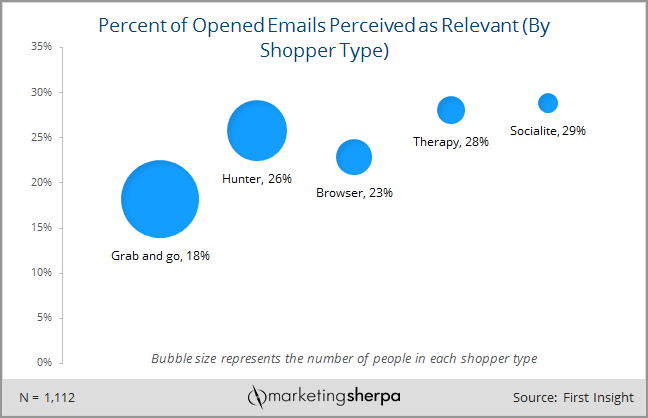customers want marketers to use; however,
| Read on marketingsherpa.com |
 |
| Download PDF |
To create engaging emails that cut through the noise in audience's inboxes, marketers need to arm themselves with a deep understanding of their customers' behaviors, interests and motivations.
This week, we look at another way to learn more about your customers — understanding what type of shopper they are, and zero in on which shopper types find retail emails more personally relevant.
Methodology
Between October 12 and November 5, 2015, First Insight conducted an online survey with 1,112 consumers across the United States regarding their thoughts about the marketing emails they receive from retailers and their impact.According to the report, consumers only open one in four retail emails.
The researchers then asked, "What percent of emails that you open do you feel are relevant to you?"
Overall, consumers said 5.5% of the emails — about one in 20 — were personally relevant. However, perceived relevance varied across different groups of shoppers.

Click to see a larger, printable version of the chart
Shopper types
To better understand consumers' preferences, the researchers asked them how they shop, applying the following five shopper types:- Grab and go: knows what they want, gets in and out as fast as possible
- Hunter: always on the lookout for a great deal
- Browser: enjoys browsing stores alone to discover latest trends
- Therapy: finds shopping to be very therapeutic
- Socialite: treats shopping as a chance to spend time with friends
Relevance by shopper types
Socialite shoppers found the highest percentage of retail emails personally relevant (29%), followed by therapy shoppers (28%), hunters (26%), browsers (23%) and grab and go shoppers (18%).It's interesting to note that the most populous type in the sample — Grab and go shoppers — reported the lowest percentage of email as personally relevant, while the least numerous type —socialite shoppers — reported the highest percentage of email as personally relevant.
To sum up, people who see shopping as a fun time with friends or as "retail therapy" are more likely to see retail email as relevant. However, these shoppers together add up to only 9% of the sample.
Since consumer buying styles vary by product types and demographics, how can marketers apply these findings to create more effective email campaigns in different industries and product categories? Joe Callahan, Director of Marketing, First Insight, offered the following two points of advice.
Build solid customer personas
Callahan emphasized that shopper types are just one dimension of a customer: His or her buying behavior — just like demographic data — will not paint a sufficiently detailed picture.
"Assuming that every 20-something female is going to be interested in the same things is another one-dimensional view. That's no better than a horoscope saying everyone born in April is going to behave a certain way," said Callahan. "Effective customer personas need to be 3D. They need to be vivid. They need to include other facets that flesh out not just who they are, but what they like and what motivates them to buy things."
Callahan pointed to two main hurdles that marketers need to overcome to build vivid personas:
- Finding, cleaning and integrating customer data from multiple internal and external sources, such as CRM, POS and social media
- Assigning each customer correctly to the right persona
Don't rely on industry stereotypes
Callahan emphasized that shopper types vary across industries and at an individual level, adding that shopping styles can even vary at different stores in the same industry (e.g., Wal-Mart will have a different split between shopper styles than Nordstrom).He added that for most people the product they're buying dictates their buying style: "I'm miserable when I'm at a grocery store, so I make my list and dash in and out. When I'm shopping for clothes, I prefer browsing. When I'm looking for a big ticket item — a car or an appliance — I'm a hunter."
Consequently, marketers need to study their customers concretely, to develop their own helpful stereotypes, while also being mindful of customers' privacy concerns.
Callahan cited Merkle's 2015 Shopper Expectations study that found that 43% of the respondents in the study would be "more willing to open an email if a retailer suggested clothes that fit [their] style."
However, just 60% of shoppers were comfortable sharing their gender with retailers, dropping down to 51% for age, 24% for education level and just 12% for household income.
Consequently, marketers have to clearly communicate to customers how gathering their personal data will be used to serve them with a better experience in terms of more relevant emails and product suggestions.
















